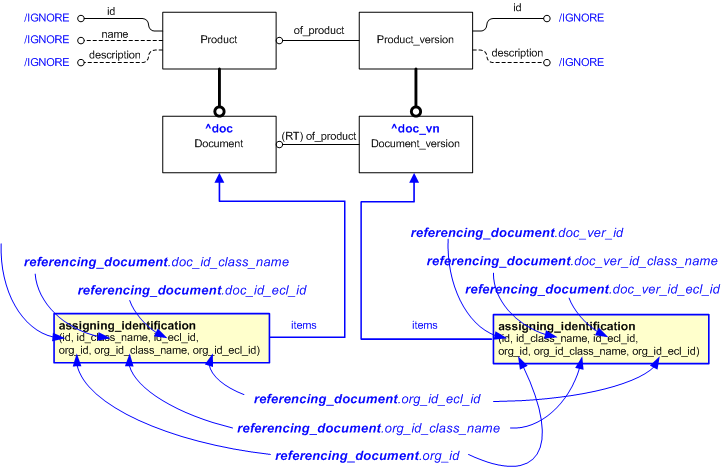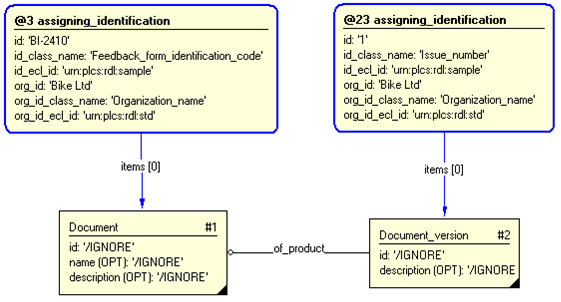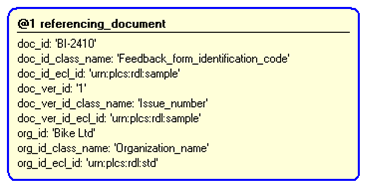Template:— referencing_document (ref_doc)
Capability:representing_documents |
Date: 2011/04/21 12:06:35
Revision: 1.2
|
This section specifies the template referencing_document.
NOTE
The template has been defined in the context of the capability
representing_documents
which provides an overall description of the
relevant parts of the ISO 10303-239 information model and a description
of related templates.
NOTE
An explanation of a template and the associated instantiation path is
provided in the
Template overview
section.
This template describes how to represent a document and its version.
The EXPRESS-G diagram in
Figure
1
shows the templates and EXPRESS entities that are required
to represent the template
"referencing_document".
The text highlighted in blue shows the template parameters.
Figure 1 — An EXPRESS-G representation of the Information model for referencing_document
The graphic for the template to be used in other EXPRESS-G diagrams
is shown in Figure
2
below.
Figure 2 — The graphical representation of the referencing_document template
The following input parameters are defined for this template:
The name of the
External_class being used to classify the assigned document identifier (@doc_id).
The following classes and their sub-classes can be used:
Document revision identifier.
The name of the
External_class
being used to classify the assigned document revision identifier (@doc_ver_id).
The following classes and their sub-classes can be used:
The name or identifier of the organization that "owns" the document and document revision identifiers (@doc_id and
@doc_ver_id).
The name of the
External_class being used to classify the identification
of the organization (@org_id) that "owns" the document and document revision identifiers (@doc_id and @doc_ver_id).
The following classes and their sub-classes can be used:
The following reference parameters are defined for this template:
Allow the
Document
entity instantiated in this path to be referenced when this template is used.
Note: The
Document
entity can be referenced in a template path by:
%^target = $referencing_document.doc%
where
target
is the parameter to which the
Document
is bound.
Allow the
Document_version
entity instantiated in this path to be referenced when this template is used.
%^target = $referencing_document.doc_vn%
The following parameter combinations specify a uniqueness constraint:
Unique constraint: Unique document
This rule means that there can be only one document
(
Document)
with any given identifier.
Unique constraint: Unique document version
This rule means that there can be only one version
(
Document_version)
of a document
(
Document)
with any given identifier.
The instantiation path shown below specifies the entities that are to be
instantiated by the template.
A description of templates and the syntax for the instantiation path is
provided in the
Templates Help/Information section.
Document-- Mark the Document entity as -- referable when this template is used by binding it to the reference -- parameter doc %^doc =
Document%
Document.id = '/IGNORE'
Document.name = '/IGNORE'
Document.description = '/IGNORE'
-- assign the identification to the Document /
assigning_identification(
items=^doc,
id=@doc_id,
id_class_name=@doc_id_class_name,
id_ecl_id=@doc_id_ecl_id,
org_id=@org_id,
org_id_class_name=@org_id_class_name,
org_id_ecl_id=@org_id_ecl_id)/
-- Mark the Document_version entity as -- referable when this template is used by binding it to the reference -- parameter doc_vn Document_version%^doc_vn =
Document_version%
Document_version.id = '/IGNORE'
Document_version.description = '/IGNORE'
Document_version.of_product ->
^doc
-- assign the identification to the Document_version /
assigning_identification(
items=^doc_vn,
id=@doc_ver_id,
id_class_name=@doc_ver_id_class_name,
id_ecl_id=@doc_ver_id_ecl_id,
org_id=@org_id,
org_id_class_name=@org_id_class_name,
org_id_ecl_id=@org_id_ecl_id)/
The following entities are instantiated with attributes as specified:
The instance diagram in Figure
3
shows an example of the EXPRESS entities and templates that are instantiated by the template:
/referencing_document(doc_id='BI-2410', doc_id_class_name='Feedback_form_identification_code', doc_id_ecl_id='urn:plcs:rdl:sample', doc_ver_id='1', doc_ver_id_class_name='Issue_number', doc_ver_id_ecl_id='urn:plcs:rdl:sample', org_id='Bike Ltd', org_id_class_name='Organization_name', org_id_ecl_id='urn:plcs:rdl:std')/
(an illustration of the consolidated referencing_document template is shown in
Figure
4 below.)
Figure 3 — Entities instantiated by referencing_document template
The instance model in STEP ASCII exchange file format (ISO 10303 Part
21 syntax) is:
#1 = DOCUMENT('/IGNORE','/IGNORE','/IGNORE');
#2 = DOCUMENT_VERSION('/IGNORE','/IGNORE',#1);
#4 = IDENTIFICATION_ASSIGNMENT('BI-2410','/IGNORE','/IGNORE',(#1));
#6 = CLASSIFICATION_ASSIGNMENT(#7,(#4),'/IGNORE');
#7 = EXTERNAL_CLASS('/NULL','Feedback_form_identification_code','/IGNORE',#8);
#8 = EXTERNAL_CLASS_LIBRARY('urn:plcs:rdl:sample','/IGNORE');
#11 = ORGANIZATION('/IGNORE','/IGNORE');
#13 = IDENTIFICATION_ASSIGNMENT('Bike Ltd','/IGNORE','/IGNORE',(#11));
#15 = CLASSIFICATION_ASSIGNMENT(#16,(#13),'/IGNORE');
#16 = EXTERNAL_CLASS('/NULL','Organization_name','/IGNORE',#17);
#17 = EXTERNAL_CLASS_LIBRARY('urn:plcs:rdl:std','/IGNORE');
#18 = ORGANIZATION_OR_PERSON_IN_ORGANIZATION_ASSIGNMENT(#11,'/IGNORE',(#4,#24));
#20 = CLASSIFICATION_ASSIGNMENT(#21,(#18),'/IGNORE');
#21 = EXTERNAL_CLASS('/NULL','Owner_of','/IGNORE',#17);
#24 = IDENTIFICATION_ASSIGNMENT('1','/IGNORE','/IGNORE',(#2));
#26 = CLASSIFICATION_ASSIGNMENT(#27,(#24),'/IGNORE');
#27 = EXTERNAL_CLASS('/NULL','Issue_number','/IGNORE',#8);
The instance diagram in
Figure
4
shows the graphic symbol for the template that is to be
used in other instance diagrams. The example template is:
/referencing_document(doc_id='BI-2410', doc_id_class_name='Feedback_form_identification_code', doc_id_ecl_id='urn:plcs:rdl:sample', doc_ver_id='1', doc_ver_id_class_name='Issue_number', doc_ver_id_ecl_id='urn:plcs:rdl:sample', org_id='Bike Ltd', org_id_class_name='Organization_name', org_id_ecl_id='urn:plcs:rdl:std')/
Figure 4 — Instantiation of referencing_document template
Characterizations
No common characterizations of the template
referencing_document
have been identified. However, the ISO 10303-239 EXPRESS model
may enable other assignments to the entities instantiated by the template.




